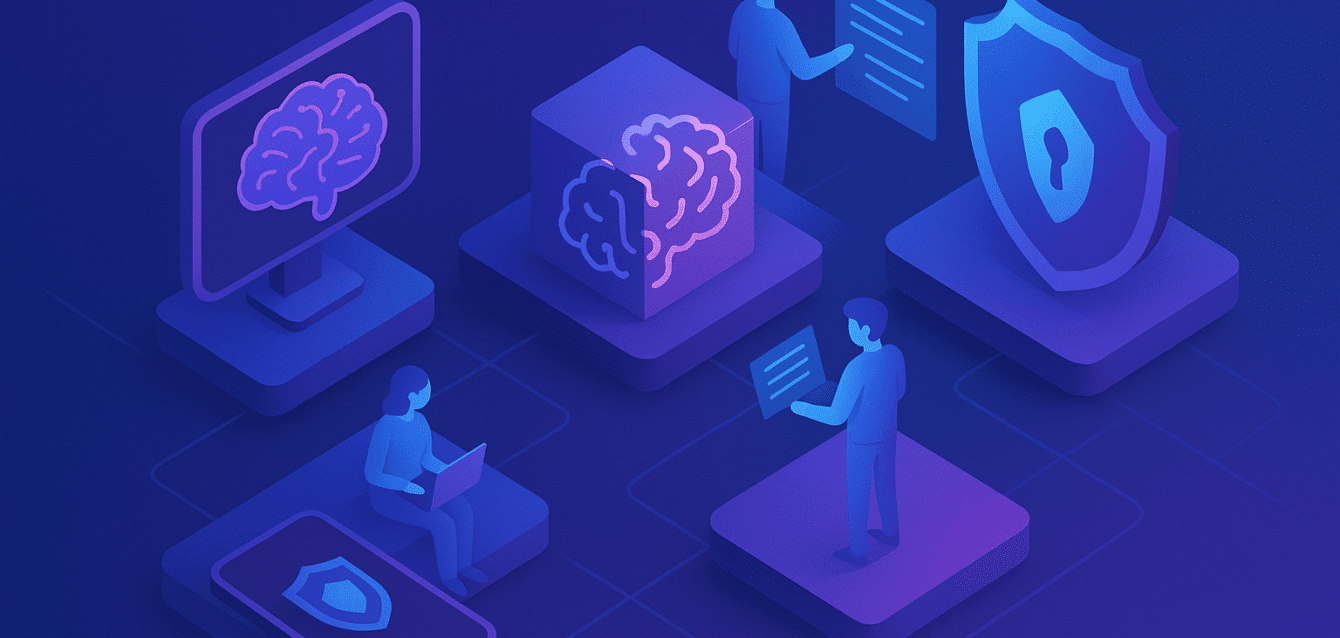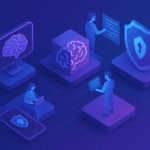It’s hard to believe, but I just hit my 30 day mark at Acuvity! It’s flown by and in just a month, I’ve had almost a hundred conversations with prospects, partners, and industry peers about the rapidly evolving landscape of Generative AI (GenAI) and AI security.
There is so much buzz and the speed of iteration and improvement is incredible! Everyone from startups to Fortune 500 enterprises is trying to understand how AI is transforming their business and how to secure this new technology responsibly.
We’ve seen these changes before in security and it’s created some of the most valuable companies and powerful cybersecurity products out there:
- We had the internet wave and that brought on firewalls and companies like Palo Alto Networks and Check Point.
- Then we had the SaaS wave and that created CASB/SASE and companies like Zscaler and Netskope.
- Most recently we’ve been riding the cloud wave and that brought about CSPM/CNAPP with the likes of Wiz.
Today we are experiencing the AI wave and no matter where you look, Gartner, Wall Street, VC Investors, Professors, everyone is forecasting that the AI market will be significantly larger than both SaaS and Cloud!
That is the market opportunity for Acuvity and why I’m so excited to be building a one in a generation company!
After a month on the ground, here are my top five takeaways on where GenAI and AI Security are headed—and why every organization should be paying attention right now.
Generative AI is Impacting Everyone—From SMBs to Fortune 500 Enterprises
When most people think about AI, they picture massive enterprises with equally massive R&D budgets. But in my first month at Acuvity, I’ve seen firsthand how Generative AI is reshaping organizations of every size.
Generative AI isn’t just for tech giants anymore. Tools like ChatGPT, Claude, Cursor, and open-source models have made AI capabilities accessible to small and mid-sized businesses (SMBs) at a fraction of the cost of traditional software. SMBs are now able to automate marketing, customer support, content generation, data and so much more! All functions that used to require large teams to scale and specialized skillsets that are now more freely available.
At the same time, large enterprises are moving quickly from pilot projects to enterprise-grade AI rollouts. From integrating LLMs into internal knowledge bases to launching AI-powered customer experiences, these organizations are thinking about how to scale AI safely and sustainably to stay competitive.
The Common Challenge? Security
Regardless of size, the challenge remains the same: how do we secure GenAI usage without slowing down innovation? Whether you’re a small business experimenting with AI tools or a global enterprise building custom models, the risks, data leakage, prompt injection, model manipulation, and compliance exposure, are very real!
BYOD (Bring your own device) is now BYOAI (Bring your own AI)! Yeah that’s not going to catch on but still any employee can put ChatGPT onto a corporate credit card for $20/mo and start using it today! Or worse, they can just use the free tiers which have even less security and controls not to mention visibility for IT/Security teams.
AI is the great equalizer in productivity, but also in risk. The same technology that helps a startup double its output can, if left unprotected, expose sensitive information or create compliance nightmares!
The Demand for AI Security is Exploding
When I say the demand for AI security is incredible, I’m not exaggerating. Within my first three hours at Acuvity, I was already meeting with prospects! I’ve been in person with F500 companies and working with MSPs to support dozens of SMBs in the same day! All focused on managing AI risks.
AI adoption is happening faster than security teams can keep up. Employees are using AI tools to boost efficiency, often without formal oversight or governance. Organizations are waking up to the reality that shadow AI usage can lead to serious security and privacy issues.
In parallel, many companies are deploying AI models internally, whether through Agents and MCP servers or the dozens of other fine-tuned open-source models. These deployments require security controls for data inputs, outputs, and model behavior. Security controls that traditional security stacks were never designed to provide.
Every Cybersecurity Vendor is Pivoting to “AI Security” and It’s Confusing Practitioners
Spend five minutes at any cybersecurity conference or on LinkedIn right now, and you’ll notice something: every vendor suddenly “does AI security.”
Endpoint vendors claim they protect AI prompts. Cloud security platforms say they govern AI usage. Data protection tools are branding themselves as AI safety solutions. SSO vendors say all GenAI tools will be behind the SSO so no need to worry. It’s no different than when SaaS or Cloud came around. The large platform companies tried to say they still have you secure but we still say SASE/CASB and CSPM vendors grow to massive size and scale.
Why This Is Important
For CISOs and security practitioners, this noise is overwhelming! They’re trying to understand what’s real, what’s just headlines, and where to invest their limited time and budget.
True AI security requires more than adding an “AI” checkbox. It involves new architectures, new monitoring techniques, and new risk frameworks.
At Acuvity, we believe clarity and education are critical. Our approach is to help organizations cut through the noise by clearly defining what AI security really means and how to prioritize risk based on real-world usage.
My two cents? When you’re evaluating AI security tools make sure to ask these questions:
- Ask vendors what specific AI use cases they protect.
- Demand transparency on how they handle data, models, and user activity.
- Look for platforms that can scale with your AI transformation from employee access to agentic workloads.
- Demand depth! Knowing Sally logged in to Copilot at 10:00am doesn’t really help. Was it the free tier or the enterprise plan? Was it just asking for a recipe or was it uploading financial documents? Was that screenshot sensitive?
Being “AI Native” Isn’t Optional Anymore
One of the biggest lessons I’ve learned in the last month is just how powerful it is to be AI native. Not a bolt on. Not just the next search engine. Foundationally being built on AI as your product as well as into your internal workflows as a company is the only way to compete in 2026 and beyond.
What Does AI-Native Mean?
Being AI-native means leveraging AI in every aspect of your business:
- Sales teams using AI to research and personalize outreach
- Marketing teams generating and optimizing content at scale
- Engineering teams automating testing and documentation
- Leadership using AI-driven analytics for faster decision-making
At Acuvity, this mindset is embedded in how we work every day. AI helps us move faster, stay aligned, and deliver more value to customers.
Here’s the reality: within 6-12 months, companies that aren’t AI-native will struggle to compete. The efficiency gap is simply too large. AI-native teams can iterate faster, experiment more, and operate with fewer bottlenecks.
It’s not about replacing people, it’s about augmenting teams with intelligent systems that multiply human capability. The organizations that embrace this now will be the ones defining their industries in the next few years.
“AI Security” Means Two Different Things AND You Need to Handle Both!
This is one of the most fascinating insights from my first month: people use the term AI Security to mean very different things.
Two Interpretations of AI Security
- Securing Human Employee Usage of AI Tools – Controlling how employees interact with AI tools to prevent data leaks, compliance issues, and misuse.
- Securing AI Employees (Agents) – Protecting the autonomous AI systems that are beginning to act as digital workers: customer service agents, copilots, or internal bots.
Both are critical and if your AI Security vendor can only do part of the job that’s not going to help!
As organizations evolve from “AI-assisted” to “AI-augmented,” they’ll increasingly rely on AI agents that can make decisions, write code, or interact with data autonomously. Securing these systems will become one of the defining challenges of the next decade.
- Today our workforce is 95% Humans, and 5% Agents.
- In 12 months it’ll be 75% Humans, 25% Agents.
- In 24 months it’s 50% Humans, 50% Agents
- In 36 months 75% Humans, 25% Agents
Platforms built today must be able to secure both human and AI users from day one! AI runs in the cloud and on your endpoint, that identity difference is important! That’s where we see Acuvity leading the way! Helping organizations establish a foundation for secure, scalable, and responsible AI adoption.
And this is only the beginning. The speed of execution, collaboration, and innovation here has been incredible. There’s a shared belief that what we’re building at Acuvity isn’t just another security platform, it’s the future of how organizations will trust and scale AI safely!
The next few months promise even more momentum. We’re expanding our product capabilities, growing our channel partnerships, and helping customers operationalize AI securely across every department.
The conversations we’re having with CISOs, CIOs, and CTOs all point to one thing: AI is here to stay and securing it is mission-critical.
Whether it’s managing employee usage of public LLMs, securing proprietary AI models, or deploying AI agents responsibly, organizations are realizing they need a new kind of security posture, one designed for AI-native environments.
AI is changing everything: how we work, how we think about data, and how we protect what matters most. But with great capability comes great responsibility.
As we continue to build at Acuvity, our mission remains clear: to help every organization innovate confidently with AI!
If you’re exploring how to secure your organization’s AI adoption, or if you’re passionate about shaping the future of AI security, I’d love to connect!
Let’s build the future of trusted AI together!





